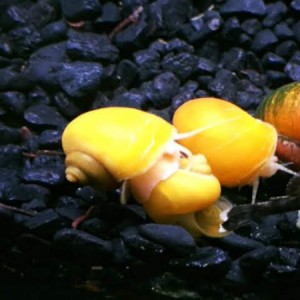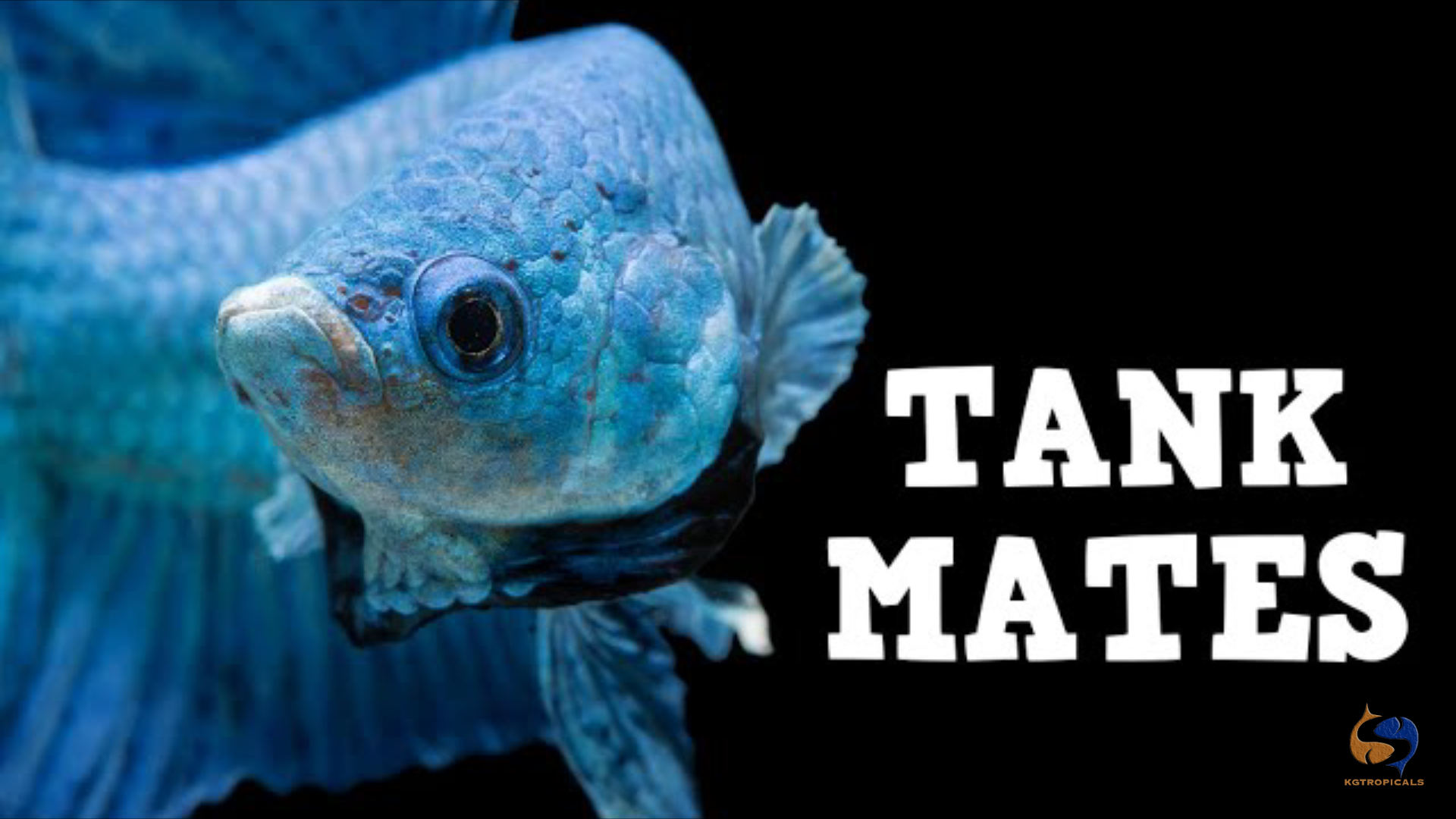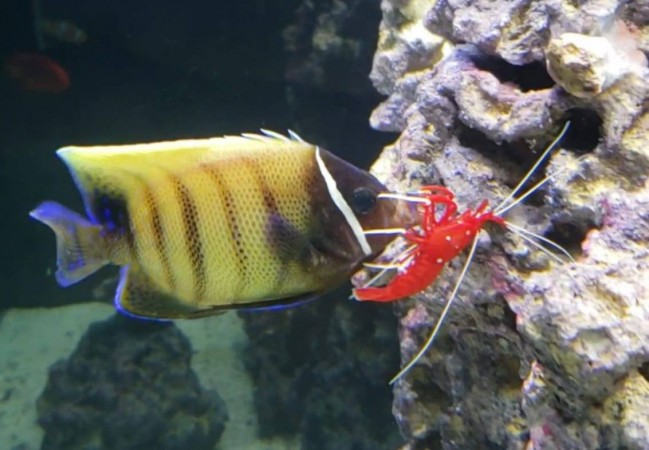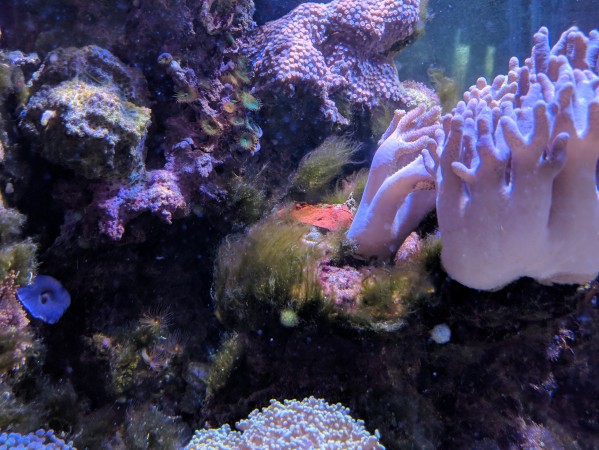- Name:
Albino Mystery Snail
- Family: Ampullariidae
- Species: Snail
- Scientific Name: Pomacea sp


General info about Albino Mystery Snail
Albino Mystery Snails are the albino coloration of the mystery snail. These large and striking snails are great for adding some color to your aquarium, but they also serve some very useful purposes. They clean algae off of glass, plants, and decorations, they eat hair algae, and they keep your substrate clean and the correct color. They are totally safe with any fish, shrimp, or plants, and are completely peaceful. These snails are quite large as adults, growing up to 3 inches in diameter. It is one of the largest plant safe freshwater snail. Albino Mystery Snails have albino-white bodies with iridescent markings, and their shells are striped with different shades of brown, making them a striking and elegant addition to any aquarium.
In their natural habitat, Albino Snails remain hidden in submerged vegetation during the day and become more active at night, sometimes leaving the water to search for fresh vegetation. In the aquarium, this snail can be very active during times when the tanks lights are on, steadily traveling throughout the aquarium on the hunt for food, interesting places to explore, or a quiet place to take a break. A Mystery Snail can also be very active when the tank lights are off, feeding at night in complete darkness. Sometimes soon after the tank lights go off, a Mystery Snail will extend its siphon and move to the surface to get some air. And for as active as a Mystery Snail can be, it is not uncommon for it to be still and appear dormant for long periods of time.
The most visible characteristic of snails belonging to the Pomacea genus is the siphon. When needed, this siphon will extend out to the water surface allowing the snail to breathe while submerged. Two to four inches of open air space above the water line in the aquarium is required as these snails need open air to breathe. The siphon in this genus is typically longer than the length of the snail's body. The shells of Albino Snails can vary significantly in color and pattern but is usually a pale yellow to white in color.
A Mystery Snail is non-aggressive and docile by nature, liking a calm aquatic environment and peaceful tank mates. Mystery Snails have no means to attack other tank inhabitants and has only its operculum and shell for protection from aggressors. Albino Snails should not be housed with any other animals that would like to make a meal of them. Possible tankmates can include Bamboo Shrimp, Vampire Shrimp, Amano Shrimp, Ghost Shrimp, Red Cherry Shrimp, Nerite Snails, Ramshorn Snails, Ivory Snails, Trumpet Snails, and Gold Inca Snails. As for fish, regular calm community tank fish can be good choices as are bottom feeders and algae eaters such as Cory Cats and Otocinclus Catfish.
They have voracious appetites and grow in size very quickly if they are fed well; a young Mystery Snail can double in size in a matter of weeks to months. Their lifespan is between 1 to 2 year. It may be longer if water conditions are good and the snail is fortunate. Like most other snails, a Mystery Snail can thrive in a small established tank like a 5 or 10-gallon aquarium. They can also do well in larger established tanks as well.
Mystery Snails can do well in a wide range of aquarium water conditions. Avoid sudden shifts in temperature and water parameters because instability can be stressful to snails. The tank should be stable, cycled and established before putting snails in. The tropical community fish tank range is a safe choice. Mystery Snails seem to also like moderately moving, clear, oxygen-rich water. A Mystery Snail also seems to adapt to environments with slower moving, murky water. İdeal water conditions are 68° - 84° F with 7.6 - 8.4 pH and 2 - 15 dKH.
A Mystery Snail prefers to be kept in aquarium water on the hard side with calcium levels sufficient to maintain healthy shells and adequate growth. Cracked, thin or excessively pitted shells can be signs of Calcium deficiency. When keeping Mystery Snails it may be a good idea to buy a Calcium test kit as well as a kH test kit. Depending on the results of those tests, periodic Calcium supplements may be necessary. But be careful with pH shifts.
It is common for a new hobbyist to add a bunch of Mystery Snails to an aquarium as an “aquarium cleaning crew”. While Mystery Snails can do a good job helping keep the tank clean, they also add to the bio-load of the tank like other living organisms. In that way, a Mystery Snail is just like any other tank inhabitant. They feed on the tank and they produce waste into it.
When buying Mystery Snails, look for snails with thick, non-pitted, non-cracked shells. Having thin, excessively pitted or cracked shells may be evidence the snail is unhealthy. It can also mean the snail has been in the acidic water long enough to dissolve the shell and weaken it. And make sure the Mystery Snail shell does not have holes. Also, look for Mystery Snails that are stuck on the aquarium glass or moving across hard surfaces. If Mystery Snails are laying still on the bottom of the tank, laying upside down or floating on the surface of the water, it may indicate the Mystery Snails are dead or dying. Finally, keep in mind that Mystery Snails can be kept in stores with tank mates that may bite off their tentacles, eye stalks, and siphon. So make sure the snail looks healthy, complete and intact before selecting.
As with other freshwater snails, it’s not difficult to identify a dead Mystery Snail. If the Mystery Snail is floating in the water for longer than ordinary, is motionless on the tank bottom, is upside down or swollen out of its shell, gently remove the snail with a fishnet. Dead snails give off a very strong, repugnant order. If this strong rotting smell is present, the snail is dead and should be kept out of the tank. If the odor is not present, place the snail back in the tank right-side up. Should the snail remains in that position for longer than usual, check again for the strong odor, as the snail may be dying. A dead Mystery Snail should be removed from a tank as soon as possible to avoid water quality problems such as Ammonia spikes.
Albino Mystery Snail Diet & Nutrition
A Mystery Snail is a scavenger and live plants never let a tank stay “too clean”. Thanks to the vegetation, there’s almost always a plentiful source of food. Shed plant matter accumulates on the tank bottom for snails to eat. The Mystery Snail diet can be based on detritus and debris from this source.
A Mystery Snail diet also includes a wide range of other naturally occurring food in a tank. Favorite natural food sources can be forms of soft filmy algae that accumulate on slow growing plant leaves, aquarium glass, and other hard surfaces. They often find algae sources growing on aquarium glass right below the surface of the gravel. They will sometimes dig a bit to get to the algae.
Other than algae, plants, and biofilm, Mystery Snails also eat leftover fish/invertebrate flakes and pellets. In addition to store-bought food, a Mystery Snail diet can have washed soft blanched vegetables such as green zucchini squash, spinach, kale, cucumber, leaf lettuce, and iceberg lettuce. Each snail is different so test different vegetables to see what works. Generally, if a snail is not interested in a vegetable or food supplement after a day or two, remove it from the tank. Leaving uneaten food in the tank can cause a decrease in water quality relatively.
Determining Sex of Albino Mystery Snail
The sex of a snail can be determined if they are the same age, have been kept in the same environment, and are fed the same foods in which case females will be larger than males
Breeding & Spawning Albino Mystery Snail
Eggs are laid in clutches, above the waterline on vegetation and generally at night, anywhere between 10 to 600 eggs can be laid. Depending on the temperature, eggs hatch after two to three weeks. The young will eat the same diet as the adults.
Albino Mystery Snail Origin
South America
Caution with Albino Mystery Snail
Ammonia and Nitrite levels should be at 0 ppm. Nitrate levels need to be kept from building up with regular partial water changes. Plant fertilizers, tank medications, and treatments can be problematic as Mystery Snails can be sensitive to their ingredients. This is especially true for additives containing copper. As with all freshwater snails, Mystery Snails are very sensitive to copper, so it's advisable to monitor your copper levels if you use tap water in your tank.
Albino snails are an expert escape artist. It is very important to keep a tank covered to the extent possible to prevent Albino snails to escape. If there is even the smallest gap in coverage, the chances are a Mystery Snail will find it. Doing periodic snail count might be useful.
A big Mystery Snail care issue involves filter intakes. A Mystery Snail may be drawn to a strong filter intake searching for an edible matter. The hazard is the Mystery Snail may get its head stuck in the slots. The Mystery Snail may stress, and its trapped head and body can swell up further complicating matters. Between the swelling and the draw of the water, the snail may not be able to remove itself, and it can die. Trying to rescue Mystery Snails trapped in a filter intake may further injure the snail or kill it. In this situation, its best to turn the filter off for a bit to see if the snail can wiggle its way out of trouble. But the better choice is to avoid the issue from the start by placing sponge pre-filters over strong filter intakes before the snails go in.
Acclimating Albino Mystery Snail
An often overlooked Mystery Snail care issue involves how a snail is added to a tank. Its best to place the snail right-side up on the tank bottom, as opposed to simply dropping it in and letting it land how it lands. Completely upside-down Mystery Snails often have a difficulty righting themselves when coming out of their shells. A Mystery Snail will open its operculum and try extending its foot to reach hard surfaces like gravel or substrate. If the Mystery Snail’s foot cannot reach a hard surface, the snail may be unable to turn right side up. If too much time passes, the Mystery Snail may die. Mystery Snails laying partially on their sides seem to fare better, but the best practice it to make sure the snail is upright when placed in the tank bottom.
Original Detail
| Name | Species | Family | Scientific Name | More Detail | Added by |
|---|---|---|---|---|---|
| Albino Mystery Snail | Snail | Ampullariidae | Pomacea sp | Albino Mystery Snails are the albino coloration of the mystery snail. These large and striking snails are great for adding some color to your aquarium, but they also serve some very useful purposes. They clean algae off of glass, plants, and decorations, they eat hair algae, and they keep your substrate clean and the correct color. They are totally safe with any fish, shrimp, or plants, and are completely peaceful. These snails are quite large as adults, growing up to 3 inches in diameter. It is one of the largest plant safe freshwater snail. Albino Mystery Snails have albino-white bodies with iridescent markings, and their shells are striped with different shades of brown, making them a striking and elegant addition to any aquarium. In their natural habitat, Albino Snails remain hidden in submerged vegetation during the day and become more active at night, sometimes leaving the water to search for fresh vegetation. In the aquarium, this snail can be very active during times when the tanks lights are on, steadily traveling throughout the aquarium on the hunt for food, interesting places to explore, or a quiet place to take a break. A Mystery Snail can also be very active when the tank lights are off, feeding at night in complete darkness. Sometimes soon after the tank lights go off, a Mystery Snail will extend its siphon and move to the surface to get some air. And for as active as a Mystery Snail can be, it is not uncommon for it to be still and appear dormant for long periods of time. The most visible characteristic of snails belonging to the Pomacea genus is the siphon. When needed, this siphon will extend out to the water surface allowing the snail to breathe while submerged. Two to four inches of open air space above the water line in the aquarium is required as these snails need open air to breathe. The siphon in this genus is typically longer than the length of the snail's body. The shells of Albino Snails can vary significantly in color and pattern but is usually a pale yellow to white in color. A Mystery Snail is non-aggressive and docile by nature, liking a calm aquatic environment and peaceful tank mates. Mystery Snails have no means to attack other tank inhabitants and has only its operculum and shell for protection from aggressors. Albino Snails should not be housed with any other animals that would like to make a meal of them. Possible tankmates can include Bamboo Shrimp, Vampire Shrimp, Amano Shrimp, Ghost Shrimp, Red Cherry Shrimp, Nerite Snails, Ramshorn Snails, Ivory Snails, Trumpet Snails, and Gold Inca Snails. As for fish, regular calm community tank fish can be good choices as are bottom feeders and algae eaters such as Cory Cats and Otocinclus Catfish. They have voracious appetites and grow in size very quickly if they are fed well; a young Mystery Snail can double in size in a matter of weeks to months. Their lifespan is between 1 to 2 year. It may be longer if water conditions are good and the snail is fortunate. Like most other snails, a Mystery Snail can thrive in a small established tank like a 5 or 10-gallon aquarium. They can also do well in larger established tanks as well. Mystery Snails can do well in a wide range of aquarium water conditions. Avoid sudden shifts in temperature and water parameters because instability can be stressful to snails. The tank should be stable, cycled and established before putting snails in. The tropical community fish tank range is a safe choice. Mystery Snails seem to also like moderately moving, clear, oxygen-rich water. A Mystery Snail also seems to adapt to environments with slower moving, murky water. İdeal water conditions are 68° - 84° F with 7.6 - 8.4 pH and 2 - 15 dKH. A Mystery Snail prefers to be kept in aquarium water on the hard side with calcium levels sufficient to maintain healthy shells and adequate growth. Cracked, thin or excessively pitted shells can be signs of Calcium deficiency. When keeping Mystery Snails it may be a good idea to buy a Calcium test kit as well as a kH test kit. Depending on the results of those tests, periodic Calcium supplements may be necessary. But be careful with pH shifts. It is common for a new hobbyist to add a bunch of Mystery Snails to an aquarium as an “aquarium cleaning crew”. While Mystery Snails can do a good job helping keep the tank clean, they also add to the bio-load of the tank like other living organisms. In that way, a Mystery Snail is just like any other tank inhabitant. They feed on the tank and they produce waste into it. When buying Mystery Snails, look for snails with thick, non-pitted, non-cracked shells. Having thin, excessively pitted or cracked shells may be evidence the snail is unhealthy. It can also mean the snail has been in the acidic water long enough to dissolve the shell and weaken it. And make sure the Mystery Snail shell does not have holes. Also, look for Mystery Snails that are stuck on the aquarium glass or moving across hard surfaces. If Mystery Snails are laying still on the bottom of the tank, laying upside down or floating on the surface of the water, it may indicate the Mystery Snails are dead or dying. Finally, keep in mind that Mystery Snails can be kept in stores with tank mates that may bite off their tentacles, eye stalks, and siphon. So make sure the snail looks healthy, complete and intact before selecting. As with other freshwater snails, it’s not difficult to identify a dead Mystery Snail. If the Mystery Snail is floating in the water for longer than ordinary, is motionless on the tank bottom, is upside down or swollen out of its shell, gently remove the snail with a fishnet. Dead snails give off a very strong, repugnant order. If this strong rotting smell is present, the snail is dead and should be kept out of the tank. If the odor is not present, place the snail back in the tank right-side up. Should the snail remains in that position for longer than usual, check again for the strong odor, as the snail may be dying. A dead Mystery Snail should be removed from a tank as soon as possible to avoid water quality problems such as Ammonia spikes.
|
PalaciosAn |
Changed by users
| Submitted Date | Submitted By | Status | Action |
|---|





